Bun or Dumpling?

Chinese Dumpling
Jiaozi (Chinese: 餃子; [tɕjàu.tsɨ] (About this soundlisten)) are a Chinese dumpling commonly eaten in China and other parts of East Asia. They are one of the major dishes eaten during the Chinese New Year and year-round in the northern provinces. Though considered part of Chinese cuisine, jiaozi are popular in other parts of East Asia and in the Western world, where they are sometimes called potstickers. Jiaozi typically consist of a ground meat and/or vegetable filling wrapped into a thinly rolled piece of dough, which is then sealed by pressing the edges together. Finished jiaozi can be boiled (shuǐ jiǎo), steamed (zhēng jiǎo) or pan-fried (jiān jiǎo) and are traditionally served with a black vinegar and sesame oil dip. They can also be served with soup.
Statistics for this Xoptio

Bun
aozi (Chinese: About this sound包子), or bao, is a type of yeast-leavened filled bun[1] in various Chinese cuisines. There are many variations in fillings (meat or vegetarian) and preparations, though the buns are most often steamed. They are a variation of mantou from Northern China. Two types are found in most parts of China and Indonesia: Dàbāo (大包, "big bun"), measuring about 10 centimetres (3.9 in) across, served individually, and usually purchased for take-away. The other type, Xiǎobāo (小包, "small bun"), measure approximately 5 centimetres (2.0 in) wide, and are most commonly eaten in restaurants, but may also be purchased for take-away. Each order consists of a steamer containing between three and ten pieces. A small ceramic dish for dipping the baozi is provided for vinegar or soy sauce, both of which are available in bottles at the table, along with various types of chili and garlic pastes, oils or infusions, fresh coriander and leeks, sesame oil, and other flavorings. They are popular throughout China.